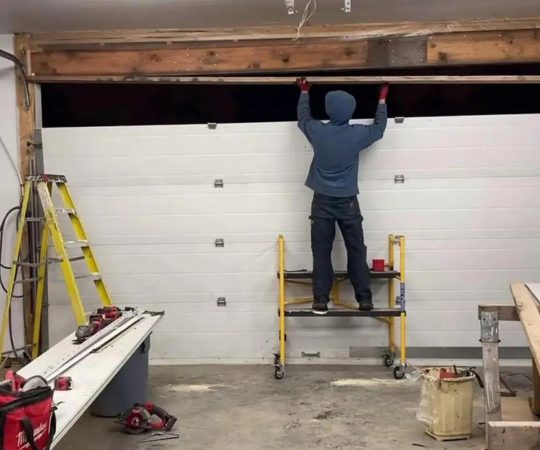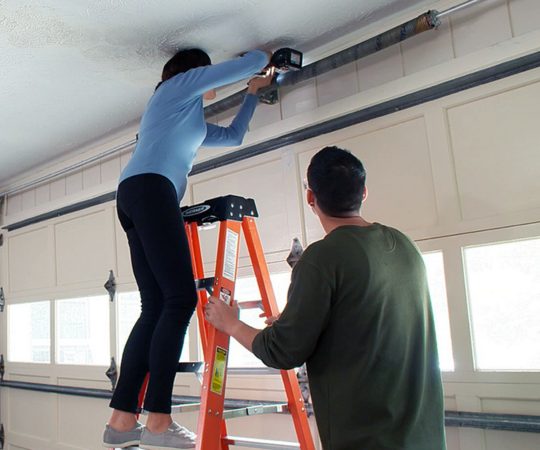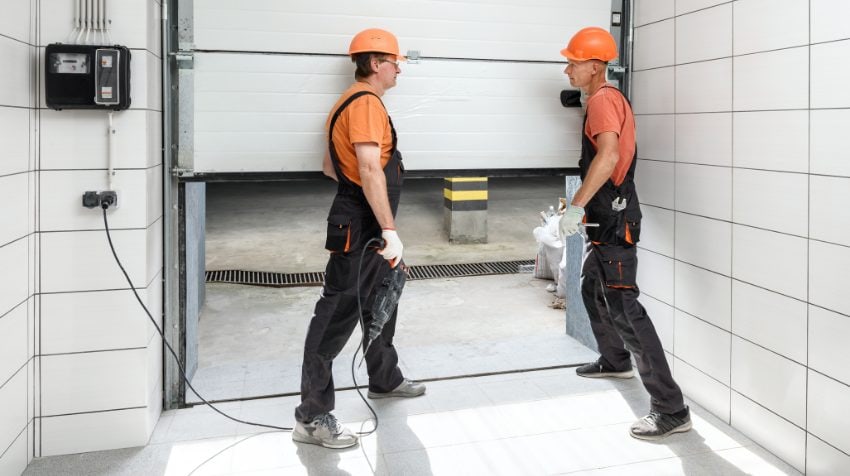DIY Garage Door Installation: Embrace Your Inner Hero and Take Control
You’ve always been the kind of person who likes to take matters into your own hands. You enjoy the satisfaction that comes from completing a task on your own, and you’re not afraid to get your hands dirty. So, why should installing a garage door be any different?
With a little bit of know-how and some basic tools, you can become your own hero and tackle this project yourself.
Installing a garage door may seem like an intimidating task at first glance, but with the right approach and mindset, it doesn’t have to be. By following a step-by-step process and taking the time to gather all of the necessary tools and materials beforehand, you can successfully install a new garage door without having to rely on expensive professional services.
Not only will you save money in the long run, but you’ll also gain a sense of accomplishment knowing that you did it all on your own. So roll up those sleeves and get ready to transform your garage into a functional space that reflects your DIY spirit.
Gather the Necessary Tools and Materials
You’ll need a variety of tools and materials to successfully install your new garage door, so let’s get started. Tool selection is crucial for this project. You’ll need a drill with various bits, an impact driver, a level, a measuring tape, sawhorses or a workbench, a ladder or step stool, safety glasses, and gloves.
In addition to the tools listed above, you’ll also need some materials such as the garage door panels with hinges and rollers already attached (if purchasing a pre-assembled kit), weatherstripping material, and nails or screws.
Safety precautions are important when working on any home improvement project. Be sure to read all instructions before beginning and follow them carefully. Wear safety glasses and gloves at all times while handling tools and materials. Also, ensure that there is adequate lighting in your workspace so that you can see what you’re doing clearly.
Once you have gathered all necessary tools and materials and taken all required safety precautions, it’s time to move on to the next step: measure and prepare the opening for your new garage door installation.

Measure and Prepare the Opening
Before diving into the nitty-gritty of getting your new entrance in place, it’s important to take careful measurements and ready the space for its impending transformation.
First and foremost, measuring accuracy is key to ensuring a successful installation. Measure the height and width of the opening multiple times to confirm your measurements are consistent. You’ll also need to measure the headroom (the distance between the ceiling and top of the opening) and sideroom (the distance from each side of the opening to any obstructions), as these will determine what size tracks you need.
As you prepare the opening, it’s crucial that you follow safety precautions. Make sure all power sources are turned off before beginning work, and keep children and pets away from the area. Clear out any debris or clutter that could impede your progress or pose a hazard.
With proper measuring techniques and safety measures in place, you’re now ready to move on to installing the tracks and springs.
Install the Tracks and Springs
Now that you’ve measured and prepared the opening for your new garage door, it’s time to move on to the next step: installing the tracks and springs.
This involves three key points: installing the vertical tracks, installing the horizontal tracks, and installing the springs.
By following these steps in a methodical manner, you’ll be well on your way to completing your DIY garage door installation project with confidence and ease.
Installing the Vertical Tracks
You can easily tackle the vertical track installation with a few simple steps, making you feel confident and capable of taking on any home improvement project.
First, make sure the tracks are aligned properly by using a level and measuring tape to ensure they’re parallel to each other and perpendicular to the floor. Use shims if necessary to adjust their position.
Then, attach the tracks securely to the wall using lag bolts and washers.
Next, lubricate the tracks with silicone spray or white lithium grease to reduce friction and prevent wear and tear on your garage door opener. Apply evenly along the entire length of both tracks.
With these steps completed, you’re ready for installing the horizontal tracks which is crucial in ensuring smooth operation of your garage door system.
Installing the Horizontal Tracks
Once the vertical tracks are securely in place, it’s time to get started on the horizontal tracks. This step is crucial because track alignment is key to smooth operation of your garage door.
Begin by attaching the horizontal tracks to the vertical ones with bolts and nuts. Once attached, use a level tool to ensure that they are level and straight. Any deviation from straightness can cause problems such as friction or binding of the rollers.
Next, lubrication techniques should be applied before installing your garage door rollers onto the horizontal tracks. Lubricate both sides of each track using a silicone-based lubricant spray for a smooth glide of your rollers along the track. The same technique should also be applied when installing springs or any other moving parts. It’s important not to use wd-40 as this will attract dust and grime instead of repelling it, which can lead to issues down the line.
With your horizontal tracks now installed and well-lubricated, you’re ready for the next step: installing the springs.
Installing the Springs
The key to a smooth and efficient garage door operation lies in the proper installation of the garage door springs, so it’s important to pay close attention to this step. The spring tension needs to be adjusted correctly, or else your garage door won’t open or close properly.
Before installing the springs, make sure you have all of the necessary safety precautions in place.
To install the springs, start by positioning them on either side of the center bracket above the garage door. Make sure they are securely attached before winding them up with a winding bar. As you wind up each spring, check that it’s aligned with the center bracket and that there’s an equal amount of tension on both sides.
Once this is done, you can move on to installing the panels.
With your springs installed correctly, you’re one step closer to having a functional garage door! Now it’s time to focus on installing the panels themselves.
Install the Panels
Install the panels.
Attach each panel to the track and make sure they align properly before securing them in place. This step is crucial to ensure your garage door operates smoothly and efficiently. You can achieve panel alignment by adjusting the tracks or hinges until they are straight and level. Once you have aligned the panels, secure them in place using screws or bolts.
To further improve the functionality of your garage door, consider installing weather stripping along the edges of each panel. This will prevent drafts from entering your garage and keep it insulated during extreme weather conditions. Additionally, it will reduce noise levels when opening and closing your garage door. Remember to measure each panel accurately before cutting the weather stripping to size.
Now that you’ve successfully installed the panels, it’s time to move on to installing the opener and accessories for a fully functional garage door system.
Install the Opener and Accessories
You’ll be amazed at how easy it is to install the opener and accessories for a fully functional garage door system. First, you’ll need to program your remotes to communicate with the opener. This process will vary depending on the brand of your opener, but typically involves pressing a button on the remote while simultaneously holding down a button on the opener itself. Make sure to follow the instructions provided by your manufacturer carefully.
Next, you’ll need to wire your sensors into the system. These sensors are essential for ensuring that your garage door doesn’t close if there’s something in its path. Typically, you’ll need to run wires from each sensor back up to the opener unit itself, making sure that they’re securely attached and not tangled or damaged in any way.
Once everything is wired up and programmed correctly, test out your new system by opening and closing the door a few times using both remotes as well as any additional buttons or keypads included with your kit.
Now that you’ve successfully installed both panels and accessories for your garage door system, it’s time to move onto troubleshooting common issues that may arise during use.

Troubleshooting Common Issues
Now it’s time to tackle any hiccups that might arise while using your new garage door system. Garage door maintenance is crucial to ensure its longevity and prevent any potential issues from occurring.
One of the most common problems is a misaligned track, which can cause the door to stick or not close properly. To fix this issue, first, disconnect the opener and manually move the door up and down to inspect for any obstructions in the track. Then, use a level to check if the tracks are aligned correctly. If they’re not, loosen the bolts holding them in place and adjust them until they’re straight.
Safety precautions should also be taken into account when troubleshooting garage door issues. Always disconnect power before working on any electrical components or mechanisms of your garage door system. Additionally, never attempt to repair or replace springs, cables or other high-tension parts as they can be dangerous if mishandled. It’s best to hire a professional for these types of repairs.
By following these safety tips and performing regular maintenance on your garage door system, you can ensure its smooth operation for years to come.
Frequently Asked Questions
How much does it cost to install a garage door?
When planning to install a garage door, it’s crucial to consider the cost of installation. Garage door installation costs can vary depending on factors such as the size and material of the door, labor fees, and additional features like insulation or windows.
To begin budget planning for your installation project, start by researching prices from reputable companies or contractors in your area. It’s also important to factor in any potential unforeseen expenses that may arise during the process.
By taking a methodical approach and being mindful of your installation budget, you can ensure a successful and stress-free garage door installation experience.
Do I need a permit to install a garage door?
Installing a garage door may seem like a simple DIY project, but it’s important to understand the permit requirements and regulations before starting. Failure to obtain the necessary permits can result in legal repercussions down the line.
Additionally, there are certain installation safety precautions that must be taken into consideration, which may require professional assistance. It’s important to know your DIY limitations and when it’s best to seek out help from experts in order to ensure a safe and successful installation process.
By taking the time to research and follow proper procedures, you can become your own hero in this home improvement project.
How long does it take to install a garage door?
Installing a garage door can be a time-consuming task, but with the right tools and tips, you can do it yourself in just a few hours.
The tools needed for this project include a drill, hammer, level, measuring tape, and screwdrivers.
Before starting the installation process, make sure to read the manufacturer’s instructions thoroughly and follow them closely.
One of the most common mistakes to avoid is not properly aligning the tracks or failing to secure them tightly enough.
To prevent this from happening, use a level to ensure that everything is straight and then tighten all screws securely.
Another helpful tip is to have someone assist you with holding up the door while installing it.
With these tips in mind and some patience and determination, you can successfully install your own garage door and feel like a true hero of your home improvement projects.
Can I install a garage door myself if I have no prior experience?
You may be wondering if you can install a garage door yourself, even if you haven’t any prior experience. The answer is yes, but it’s important to weigh the pros and cons before diving in.
On the one hand, DIY installation can save you money and give you a sense of accomplishment. On the other hand, it can be time-consuming and potentially dangerous if not done correctly. Before starting your project, make sure to research DIY tips and techniques for garage door installation.
Consider enlisting the help of a friend or family member with experience in home improvement projects. Ultimately, whether or not to tackle this project on your own depends on your level of comfort with tools and willingness to take on a challenge.
What should I do if I encounter unexpected problems during the installation process?
Encountering unexpected problems during the installation process can be frustrating, but don’t panic. There are several troubleshooting tips you can try before seeking professional help.
First, double-check that all components are installed correctly and securely. If a part is loose or misaligned, it could cause issues with the door’s operation.
Secondly, make sure the programming and settings on your opener are correct. Check for any error codes or flashing lights that may indicate a problem.
Finally, if none of these solutions work, it may be time to seek professional help. Don’t hesitate to call a technician who can diagnose and fix any issues quickly and efficiently.
Remember, safety should always come first when dealing with garage doors, so don’t take any risks if you’re unsure about how to proceed in troubleshooting an issue yourself.
Conclusion
Congratulations! You’ve successfully completed the installation of your very own garage door. Not only have you saved money, but you’ve also gained valuable skills and knowledge that will come in handy for future home projects.
Did you know that according to a recent survey, 60% of homeowners prefer DIY home improvement projects? It’s no surprise why. With the right tools, materials, and a bit of patience, anyone can tackle a project like installing a garage door.
Remember to always prioritize safety when working with heavy machinery and follow all instructions carefully. Take pride in your accomplishment and enjoy the convenience of having a fully functioning garage door at your fingertips.
Keep on DIY-ing!
Related Source

